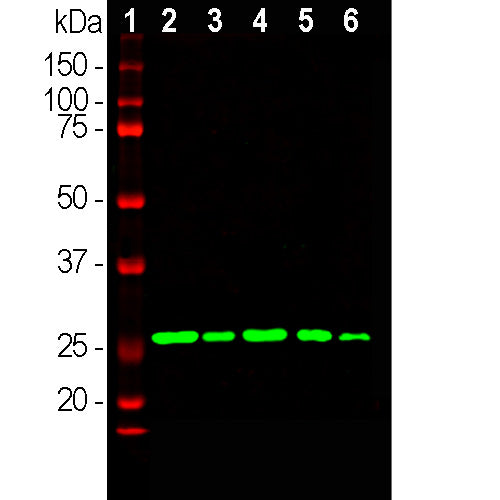

EnCor Biotechnology
Rabbit Polyclonal Antibody to Calretinin, Cat# RPCA-Calret
Description
The RPCA-Calret antibody was made against full length recombinant human calretinin expressed in and purified from E. coli. The calretinin protein is related in amino acid sequence to calbindin and to a lesser extent parvalbumin, so, for studies of GABAergic interneurons, it is important to verify that antibodies developed against one protein do not cross-react with either of the others, which we have done using appropriate recombinant human proteins. We also document that the antibody works well not only for western blotting, IF and ICC but also for IHC on formalin fixed paraffin embedded sections, select the "Additional Info" for this data. We also manufacture mouse monoclonal antibodies to calretinin MCA-3G9 and MCA-6A9, and a chicken polyclonal CPCA-Calret. We also supply a variety of other mouse, rabbit and chicken antibodies to the related proteins calbindin and parvalbumin allowing double and triple labeling of appropriate cell and tissue samples.
Add a short description for this tabbed section
| Immunogen: | Full-length recombinant human calretinin protein expressed in and purified from E. coli. |
| HGNC Name: | CALB2 |
| UniProt: | P22676 |
| Molecular Weight: | 29kDa |
| Host: | Rabbit |
| Species Cross-Reactivity: | Human, Rat, Mouse |
| RRID: | AB_2572244 |
| Format: | Serum plus 5mM NaN3 |
| Applications: | WB, IF/ICC, IHC |
| Recommended Dilutions: | WB: 1:5,000-10,000. IF/ICC or IHC: 1:5,000-1:10,000. |
| Storage: | Store at 4°C for short term, for longer term store at -20°C. Stable for 12 months from date of receipt. |
Calretinin is a member of the large superfamily of cytoplasmic Calcium binding proteins and is expressed in mammalian central nerve system, testis, fallopian tube and pancreas (1). It contains “EF hand" type Calcium binding motifs and in the brain is localized in certain classes of neurons, the prototype for which is parvalbumin (2-4). Calretinin is particularly concentrated in some cerebellar granular cells and their parallel fibres, but is also found in many GABAergic interneurons in the cortex. These GABAergic interneurons in most cases express only one of three related Calcium binding proteins, namely calretinin, calbindin or parvalbumin. As a result these important inhibitory interneurons can be identified and classified based on their content of these three proteins (5,6). Each type of neuron as defined in this fashion has distinct electrophysiological and functional properties (7). The function of calretinin appears to be primarily buffering the Calcium level in cells and affect intracellular Calcium signals. Calretinin deficiency in mice in the mossy cells of the dentate gyrus and granule cells results in abnormal excitability in the cerebellar neuronal network and impairment of long-term potentiation and motor coordination (8).

Chromogenic immunostaining of a NBF fixed paraffin embedded human brain cortex section with rabbit pAb to calretinin, RPCA-Calret, dilution 1:5,000, detected with DAB (brown) using the the Vector Labs ImmPRESS method and reagents with citrate buffer retrieval. Hematoxylin (blue) was used as the counterstain. The RPCA-Calret antibody strongly labels the cytoplasm and nuclei of GABAergic interneurons in the cortex. This antibody performs well in testing with 4% PFA and standard NBF fixed mouse, rat, and human tissue. Mouse select image for larger view.

Immunofluorescent analysis of mouse cerebellum section stained with rabbit pAb to calretinin, RPCA-Calretinin, dilution 1:5,000 in red, and costained with mouse mAb to calbindin, MCA-5A9, 1:2,000 in green. The blue is Hoechst staining of nuclear DNA. Following transcardial perfusion of mouse with 4% paraformaldehyde, brain was post fixed for 24 hours, cut to 40μM, and free-floating sections were stained with above antibodies. The calretinin antibody stains interneurons predominantly in the granule cell layer, while calbindin antibody labels the dendrites and perikarya of Purkinje cells in the molecular layer of cerebellum.
1. Rogers JH. Calretinin: a gene for a novel calcium-binding protein expressed principally in neurons. J. Cell Biol. 105:1343-53 (1987).
2. Kretsinger RH, Nockolds CE. Carp Muscle Calcium-binding Protein: II. Structure determination and general description. J. Biol. Chem. 248:3313-26 (1973).
3. Andressen C, Bliimcke I, Celio MR. Calcium-binding proteins: selective markers of nerve cells. Cell Tissue Res. 271:181-208 (1993).
4. Schwaller B, Meyer M, Schiffmann S. ‘New’ functions for ‘old’ proteins: The role of the calcium binding proteins calbindin D-28k, calretinin and parvalbumin, in cerebellar physiology. Studies with knockout mice. The Cerebellum 1:241–58 (2002).
5. Condé F, et al. Local circuit neurons immunoreactive for calretinin, calbindin D‐28k or parvalbumin in monkey prefronatal cortex: Distribution and morphology. J. Comp. Neurol. 341:95-116 (1994).
6. Hof PR, et al. Cellular distribution of the calcium-binding proteins parvalbumin, calbindin, and calretinin in the neocortex of mammals: phylogenetic and developmental patterns. J. Chem. Neuroanat. 16:77-116 (1999).
7. Bearzatto B, et al. Mono- and dual-frequency fast cerebellar oscillation in mice lacking parvalbumin and/or calbindin D-28k. Eur. J. Neurosci. 22:861-70 (2005).
8. Schiffmann SN, et al. Impaired motor coordination and Purkinje cell excitability in mice lacking calretinin. PNAS 27:5257-62 (1999).
Add a short description for this tabbed section





